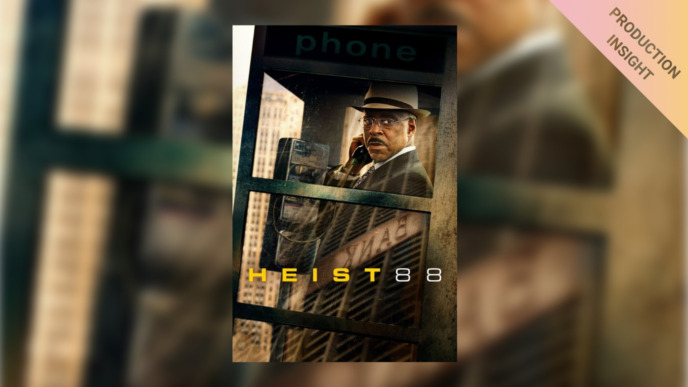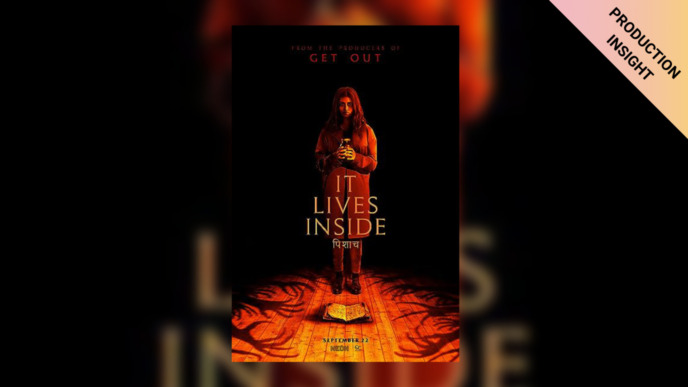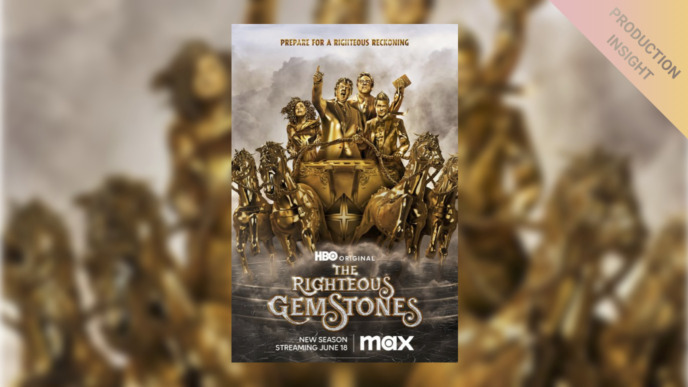
The British comedy-drama series “Sex Education” is centered around a teenager who sets up a secret sex therapy clinic at his school. While a captivating story unfolds on screen, the show’s production was no less eventful and came with exciting learning lessons of its own.
In this interview, DIT Shibbir Ahmed takes us behind the scenes of Season 3 to share insights into his workflow with Silverstack XT and some unique technical challenges – like needing to incorporate analog prop cameras into the mix of digital cameras.
First of all, thank you for sharing some insights into your work with us! To start with, could you tell us a bit about yourself and your work?
My name is Shibbir, and I’m a London-based DIT. I’ve been in the industry since 2007, starting off at BBC Factual in White City working for their in-house edit facility. I was one of the digital techs who was responsible for digitizing rushes and supporting the Final Cut Pro edit suites.
During my time, I’d go on to help productions as they transitioned to tapeless cameras like the Panasonic P2 and Canon XF305’s/C300’s and worked as an edit assistant on shows overseeing the whole tapeless workflow.
After six years of being staff, I was looking for a change and wanted to be in the field more and be closer to set. I ended up speaking to a DOP who suggested I look into becoming a DIT, as it’d get me on set, utilize the skills I already had and also give me a chance to learn how to grade. I took the leap, went freelance and have been working as a DIT ever since.
What kind of projects are you usually working on?
My bread and butter as a DIT are long-form comedies & dramas. I started off doing some BBC dramas but enjoyed doing comedies, which resulted in doing shows like “Catastrophe” and “Detectorists”. The most recent projects have been shows like “The Pentaverate” and a Paramount+ series called “The Gold”. When I’m not on long-form projects, I try to fill in the gaps by dipping into the world of commercials.


So as you said, you recently worked on Season 3 of the Netflix Original “Sex Education”, using Silverstack XT. Can you tell us a bit about this project? How did the team come together, and what role did you play?
“Sex Education” is a Netflix series that tells the story of Otis Milburn, who, with the help of his classmate Maeve Wiley, sets up an underground sex therapy clinic on campus to help their fellow students navigate the angst of teenage life and their sexual problems.
I came on board for season two. I had worked with the DOP Jamie Cairney years before on a few pilots but never had a chance to do anything beyond that. Five weeks before S2 was gearing up to shoot, I got a text out of the blue asking if I’d like to go work in Wales for five months. I was in a dilemma as I was about to start another project. But the lure of doing my first Netflix gig, working alongside friends/colleagues who I knew from past projects, on one of the biggest Netflix shows was too good to turn down. Honestly, it turned out to be one of the best decisions I’ve made in my career.
Once I was signed up, I got to work designing the workflow. Jamie wanted to incorporate an ACES workflow as well. It was a new way of working for me but an opportunity to learn a lot. Once the shoot started, my role was to be near set, offloading the rushes and grade the dailies to match the look and style established on S1.
Once S3 got green-lit, I was knocking at the producer’s door looking to come back once again. Oli Russell would be the DOP for season 3, but he knew the show inside out, having done episodes 5-8 of S1. We had a chat, and luckily for me, Oli was happy to have me on board. I reinstated the same workflow from S2, tweaking it for the new elements introduced in S3.
Which cameras were used on this project?
We had three Sony Venice’s, which were our main cameras on set, as well as two more bodies on the 2nd unit. We managed to capture the whole series in 4K using Sony’s X-OCN ST codec. This meant we could shoot RAW, but the files were light on data, which helped me offload quicker and reduced our overall storage needs.
We introduced a few other cameras and formats on S3. We had the RED Helium shooting (8K 5:1 compression) and Komodo (6K MX Codec), as well as the DJI Inspire on our aerial units. We had an Alexa Mini and Panasonic GH5 for a couple of ‘trick’ shots, and if that wasn’t enough, we went old school and shot on BETACAM SP too.
We really threw the kitchen sink at the series. All told, we shot for 123 days, generating 104.78TB’s, 318 hours of footage, over 2300 slates, grading nearly 29 million frames.

Why did you decide to use Silverstack XT for this project? Were there any specific production requirements that influenced this decision?
By the time I got to “Sex Education”, I had been using Silverstack for years. It’s an intrinsic piece of software in my toolkit. I trust the software to securely handle the offload process, and if there are any issues, they’ll be flagged pretty quickly.
The speed and ease of use is a key factor for me. The only difference was I had to upgrade to XT to handle the Venice’s X-OCN codec, which wasn’t a major issue. Features-wise, the checksum verification was essential given the amount of copies that were being made on set. Also, I love the various DIT reports options available in Silverstack XT; it allowed me to create detailed reports tailored for the production, assistant editors, and post-production teams respectively.
Can you please briefly describe your on-set workflow? For which aspects of your work did you use Silverstack XT? How did Netflix’s production requirements influence your workflow?
Netflix have a “3-2-1 principle” for their productions. It meant we had to produce 3 verified copies of all the original camera and audio files, on 2 separate media types (Raid and LTO) and hold one of the copies in a different location.
For season 3, I upgraded my setup to include a 2019 Mac Pro. I needed something more powerful to handle the offload and transcoding of the data, particularly after the lessons I learned on S2.
I have a pretty standard way of working. Once a scene is complete, we’ll reload both cameras. I’ll then get to work by offloading the mags to my DIT Raid, which is a TB3 G-Speed Shuttle XL, as well as the production raid, which again was a G-Speed Shuttle XL & the 3rd copy was to a 2TB EV-RAW SSD shuttle drive.
The great thing about Silverstack XT is that whilst I waited for the checksums to happen, I could also use that time to scan through shots in the preview mode and label up slate info.
Once the offload is done, I’ll bring the rushes into an ACES project in Davinci Resolve, where I begin to drop each reel onto a timeline and then I’ll get to work grading the individual shots to match each take, as well as each camera. I’ll do a further QC and then transcode out Avid proxies for the edit. Once I’m happy, I’ll produce CDLs/ALEs to accompany the transcodes and include my DIT reports that correspond to each offloaded mag plus an overall daily report for the edit to cross-reference everything.
The shuttle drive would then be delivered to our post-house so they could produce the LTO copies in addition to uploading the dailies to our offline edit in London.

How was your overall experience using Silverstack XT? Were there any features that you used frequently or liked in particular?
I think for most DITs in the industry, Silverstack is a gold standard. It’s a fantastic data management piece of software. The back-end support from Pomfort was invaluable. If I had any questions or issues, they were quick to respond. The software is constantly evolving and being updated. Case in point was when we shot with the RED Komodo quite late into the schedule, it was a relatively new camera and codec. I was worried the files and metadata wouldn’t be recognized, but turns out there was already an update available to deal with this issue.
Were there any technically challenging situations or setups on this project? How did you address them?
On season 3, there were a few technical challenges presented to me, but it’s all a part of working on the show. It was mainly around the usage of BETACAM SP and some analog Ikegami Studio cameras. Anyone who is familiar with the show will know that whilst it’s very much set in the present day, the props/technology in the series really harken back to anywhere between the ’60s-’90s.
In the first episode, a local news crew turns up at the school to conduct some interviews. Ben Taylor (director and show runner) wanted to have the news crew to turn up with a BETACAM SP as their main camera. The aim was to capture the in-camera artifacts you’d associate with shooting with those analog formats and not have to add them in post.
I was over the first hurdle in that I knew what a BETACAM SP was and how to deal with the format. We just needed to make sure the prop camera was still functioning and then source stock for it as well as getting it ingested. It was a team effort between Camera, Art Department and our Post-Production Supervisor to get it all working, but it turned out really well.
In episode 7, there was a scene where Gillian’s character visits a TV studio to do an interview promoting her book. Due to various reasons around COVID and location availability, the production decided to build the set within the University campus, which was our production base and home to various sets/locations seen in the series.
The DOP Oli Russell and our wonderful production designer Sam Harley floated the idea of building a rig that could act as a live studio gallery and crash record three analog feeds from the 40-year-old Ikegami Pedestal cameras we had lined up as props. I’d never done anything remotely close to this before, but I figured it was something I could teach myself. After some initial research, I came across Blackmagic Design’s Analog to SDI mini converters, which then could be fed into an ATEM mixing desk, and the three individual feeds could subsequently be captured on some Hyperdeck recorders. All the footage would later be uprezed in post.
The resulting shots from both the BETACAM SP and Ikegami cameras are fleeting on screen, but the post-production team did an incredible job bringing those shots to life and getting them to sit so perfectly alongside all the 4K footage. It made the endless hours of research and testing worthwhile.
When you think back to the production, what is your most memorable experience? What did you enjoy the most?
To be honest, I have so many memories from both S2 & S3 its hard to pick a favourite. I loved working on the series primarily because of the cast and crew. Every single department was based on the campus, and that allowed me to interact with every single member of the crew that you might not ordinarily meet. We all were there because we were fans of the show, and it felt like a collective all pushing in the same direction. That’s a rare feeling when you’re making TV.
I think the best moments truly were when we’d have multiple units/splinter crews shooting across the university campus. I’d cover all the units and be running all over the place to collect reloads or check in with people. It felt like working on the backlot of an old MGM musical; there was always something weird and wonderful going on everywhere you looked.
Thank you so much for sharing these insights with us!
Shibbir Ahmed, DIT
Shibbir Ahmed is a freelance DIT based in London. With more than 14 years of experience in broadcast TV, he’s started his career at the BBC working in post-production as an FCP edit assistant before moving across to work on set as a DIT for high-end comedy and dramas.
IMDb Profile
Instagram Profile



